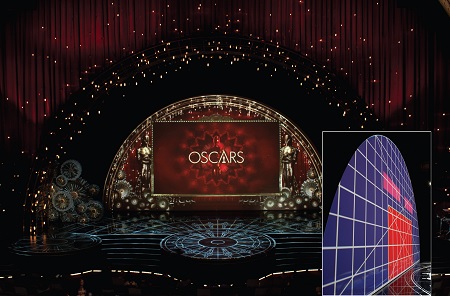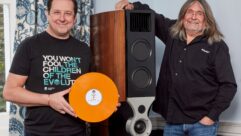


The LED set up included one big screen cyclorama, permanently upstage. It was a 70 X 35 foot 9mm LED wall, a similar screen configuration to the one SenovvA has used for several Oscars. The LED cyclorama uses almost six hundred Winvision 9.375mm LED tiles.
Just as winning an Oscar is the pinnacle of movie industry accomplishment– or at least public recognition of that accomplishment – staging the Oscars is something close. What live event is as high profile, or technically challenging, as making staging magic for not just a room full of magic makers but for millions of remote viewers worldwide?
Over the years we’ve looked at the changing staging approaches at the Academy Awards ceremony– and we’ve seen different mixes of video with traditional staging technology, and with LED walls.
For the Oscars in 2011, seventy-three high lumen staging projectors were used to create sets, i.e. digitally paint flown scenic elements, as opposed to just projecting film clips, etc. onto regular screens. In that 2011 production, the designers wrapped projected images around physical sets to “make the set come to life.” For the ceremony in 2012, LED probably played its biggest role ever. There were a great deal of video clips being shown on the stage– and it mainly was the old-fashioned kind in terms of content: IMAG, or film clips on screens, all resulting in a more traditional, music-heavy, and Broadway-style production. And the stage was itself was more traditionally theatrical, and featured over 100,000 Swarovski crystals (weighing over 1,500 pounds) into the Oscar’s stage design (and more than a thousand replica Oscar statuettes– each a little larger than the real award– was nestled in its own cubbyhole in a traditional proscenium and could be lit separately or in sections as needed). And the 2013 and 2014 Oscars continued these trends, using LED in new ways to both create broad video/movie canvases on stage and to blend video and set pieces seamlessly.
All of these trends are part of the Academy of Motion Picture Arts and Science’s retooling of the retitled “Oscars” ceremony to create a more Grammies-like fast-paced show, not a stodgy Awards Ceremony, while still needing to dazzle. And key to that effort has been the enlisting of SenovvA– and heading up SenovvA’s team, Oscar veteran Dave Taylor, SenovvA’s Vice President and Executive Producer.

Staging the Oscars, from left to right: John Berger, IATSE Local 33; Jeremy Hochman, LED Systems Design Engineer; Jim Agnor, Display Systems Engineer; Scott Goegebuer, Projectionist; Eric Snodgrass, IATSE Local 33, Scott Blair, LED Systems Design Engineer; SenovvA’s Eric Leverton, Lead LED Engineer; SenovvA’s Dave Taylor, Project Manager; Bill Starnes, LED Engineer; Mark Brayton, IATSE Local 33; Joe Sebenius, LED Engineer; Luke Frey, Lead Projectionist.
While SenovvA has been providing the projection (and LED) for the Oscars since 2006, Dave Taylor has twenty-six years experience working on the event. Taylor first did the projection for the event at the 61st Academy Awards, and he’s been on the job ever since (first, working with AVHQ, later with Creative Technology, and now with SenovvA). Before joining SenovvA at it’s founding in 2005, Dave spent a decade within the live entertainment industry as an independent Video and Technical Director and Technical Manager. His many skills include lighting and scenic design, scenic construction, audio systems and engineering, multi-image and film projection, multi-image programming, video projection, display and engineering, and installation design. His credits include 27 years on the Academy Awards, 16 years on the Emmy Awards, as well as various Political Conventions, Olympic Ceremonies and countless other live broadcasts. He has been the Technical Producer of the semiannual Television Critics Association Press Tour for 25 years, and has been an integral part of the event since 1981. His impressive client list includes NBC, ABC, CBS, FOX, HBO, Showtime, Discovery Networks, MTV, Turner Broadcasting, The Academy of Television Arts and Sciences, The Academy of Motion Picture Arts and Sciences, and many other television clients. The non-broadcast clients include: Ford, Toyota, GM, Apple Computers, Microsoft, Intel, Sun Microsystems, and many more.
This year’s Oscar ceremony, the 87th Academy Awards ceremony, directed by Hamish Hamilton, brought interesting twists to the technology story of staging the Oscars– especially the story of how top stagers are learning to tweak LED to make it blend more with other technologies on stage and also to look better on camera for remote viewers.

The second LED element consisted of two tracking “carts”: 15 ft square each, 3mm LED, down stage center (seen here, butted for a 16X9 image, in center of photo/stage). These tracked via a PRG Scenic automation system. According to Dave Taylor the tracking was “…greatly improved from last year. The tracking was much smoother. The track was sunk into the floor, not laying on top of the floor like last year. So the two elements came together more smoothly, consistently.”
The LED set up included one big screen cyclorama, permanently upstage. It was a 70 X 35 foot 9mm LED wall, a similar screen configuration to the one SenovvA has used for several Oscars. The LED cyclorama uses almost six hundred Winvision 9.375mm LED tiles. There was a Rose Brand diffusion screen that stayed in place about ¼ inch in front of the LED. The diffusion screen served to eliminate the Moiré pattern you would get if you tried to video capture the screen without one. The diffusion screen also serves to smooth out the image for both the camera and the live audience in the room– the diffusion screen has the effect of turning the LED into thousands of tiny video projectors projecting less than an inch out to the diffuser screen. And as an added bonus, it allows a less drastic dialing down of the LED wall intensity to balance with the other lighting.
The second LED element consisted of two tracking “carts”: 15 ft square each, 3mm LED, down stage center. These tracked via a PRG Scenic automation system. According to Dave Taylor the tracking was “…greatly improved from last year. The tracking was much smoother. The track was sunk into the floor, not laying on top of the floor like last year. So the two elements came together more smoothly, consistently.”
LED has not taken over at the Oscars. There was high lumen video projection to bring the sets to life, and to bring movies to life– it’s the Oscars after all.
For the 16X9 format, 38×21 ft. screen that flew in and out some half dozen times, Stewart Filmscreen’s VideoMatt 200 was used. And doing projection duty were Barco HDWF26 projectors.
And the pièce de résistance, projection-wise? The “opening screen”, the 50 ft. semicirclular screen that filled the proscenium arch and was used primarily (but not exclusively) for the Oscars opening number. On it were projected four primary Barco HDQ2K40 projectors (40K lumen each), to stunning effect. (A Hippotizer was the source for all of the background graphics, operated by Jason Rudolph. But a “package roll” came from the video truck for movie clips and other content.)

The back of the two LED tracking “carts” down stage center.
Indeed, the show’s opening number Moving Pictures was amazing, the pièce de résistance of the Oscars this year. And according to Dave Taylor this year was the first one where the stagers had a rehearsal specifically for the opening number. SenovvA set up a full scale version, in Hollywood, to make sure the set piece, live would accomplish what it needed to, and fine-tune a set that had to get the projectors 32 feet in the air, to shoot down at extreme angles with a live performer– the host– very close to the screen.
The number featured the Oscars host, Neil Patrick Harris, singing the original song for the ceremony, Moving Pictures, that both paid tribute to the movie industry and lampooned recent Hollywood trends. Technically, the producers had to start with Neil Patrick Harris out in front of the LED cyc, opening the song, then blend him into a long video clip that showed scenes from a variety of Hollywood blockbusters over the past 40 years. Off camera, soon after the opening of the song, the big semicircular projection screen was lowered. Harris first danced and sang in front of it– close to it– then the screen went full frame for the TV Audience and Patrick Harris entered the movie clips. He was literally CGI’d into scenes from Star Wars, The Wizard of Oz, Field of Dreams, and a few more movies. Then toward the end of the number, he “jumps” off the screen and back live on stage, to finish the number with Anna Kendrick on stage and Jack Black crashing the set from the audience to decry that “… this industry’s in flux, it’s run by mucky mucks, now it’s market trends and fickle friends and marketing baloney… Trust me Neil you’ve better off just polishing your Tony!”
The Moving Pictures number stole the show at the Oscars– although the other amazing number of the show, Lady Gaga performing a medley of tunes from The Sound of Music, was also impressive. And that Sound of Music/Julie Andrews tribute also saw the big semicircular screen flown down to do projection duty as scenes from the fifty year old classic were shown before Lady Gaga’s medley. Both numbers required a great deal of skill blending not just video projection with LED, but both with complex live performance.
Indeed, as the frenetic Jack Black cried out in the opening number while Neil Patrick Harris was waxing eloquent about the magic and thrill of the movies, the industry itself is in flux:
… pitching tents for tent poles, and chasing Chinese bucks,
Openings with lots of zeros, all we get is superheroes!
Superman, spiderman, batman, sequelman and prequelman,
Formulated scripts!
The only screens we’re watching are the screens like these! [as he pulled a smartphone from his pocket].
May be, but the magic of movies, millions of pixels on screens… they may not be real life but they’ll show you what life really means… sang Neil Patrick Harris.
Some are not sure what the movie industry holds–as people now watch movies on television, and indeed watch them on cell phones. But one night in March, with the help of not just Hollywood but with the help of one the most proficient staging production companies around, the magic was there again, even for a room full of pros who can see the man behind the curtain. The magic of the big screen is not going away– in a room or on another screen or another. Moving pictures are here to stay– they will only get better.










